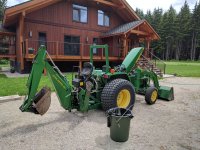Drunkwater
New member
Hi Folks! I just picked up my first ever real tractor, a brand new (to me) 1990 JD 970, and I'm very happy. It's only got 2000hrs, and is in excellent condition over all. It came with the 80 loader, 8A backhoe and some clamp-on pallet forks. It was purchased knowing the PTO clutch was siezed. The only other issue is the tires are a bit dry rotted, particularly the fronts, which will need to be replaced in the next few years. I'm using it on 5 acres of forested property in the BC interior. It's a seasonal residence, so this purchase is as much 'toy' as 'tool'. The property has lots of slope, so I've been driving very gingerly to start, and avoiding cross-slope traversing. It's got loaded turf tires installed in the 'wide' position, so it feels very stable. I'm going to use it to excavate the earth basement of the house for proper footings, plus assist with landscaping and forestry/clearing of the more heavily wooded areas (intent is to have a personal orchard, the soil is way too rocky to attempt a 'real' garden.
Of course the first thing to do was find a place to dig a hole. We cut down some large fir trees about 5 years ago along the edge of the yard, so the first task was pulling a stump. 'Only' 3 hours later and it was out. I work in an office, so I don't have any equipment operating experience; it took some time for the muscle memory to build up. I was also operating at lower revs at first to keep the machine movements a bit slower, and to help protect the machine from my inexperience. That worked well, but I found the cylinders were starved for flow, and would operate one at a time - I think that slowed my learning down a lot. The soil is rocks glued together with hard clay, so it also took some time to develop an efficient digging style. I found that taking a pass over the hole and 'stirring' the top layer with the bucket teeth helped loosen the rocks so that on the next pass they would roll out, rather than staying put and bogging the machine down.
I'm wondering how you guys like to set the loader and stabilizers down for backhoe work? I had both taking about 50% load off the wheels, which seemed to work, but I've seen comments to lift the wheels entirely, or have the wheels fully on the ground so the loader/stabilizers just act as safety or backup. Thoughts?
Here it is after looking it over at the seller's place:

Of course the first thing to do was find a place to dig a hole. We cut down some large fir trees about 5 years ago along the edge of the yard, so the first task was pulling a stump. 'Only' 3 hours later and it was out. I work in an office, so I don't have any equipment operating experience; it took some time for the muscle memory to build up. I was also operating at lower revs at first to keep the machine movements a bit slower, and to help protect the machine from my inexperience. That worked well, but I found the cylinders were starved for flow, and would operate one at a time - I think that slowed my learning down a lot. The soil is rocks glued together with hard clay, so it also took some time to develop an efficient digging style. I found that taking a pass over the hole and 'stirring' the top layer with the bucket teeth helped loosen the rocks so that on the next pass they would roll out, rather than staying put and bogging the machine down.
I'm wondering how you guys like to set the loader and stabilizers down for backhoe work? I had both taking about 50% load off the wheels, which seemed to work, but I've seen comments to lift the wheels entirely, or have the wheels fully on the ground so the loader/stabilizers just act as safety or backup. Thoughts?
Here it is after looking it over at the seller's place:

